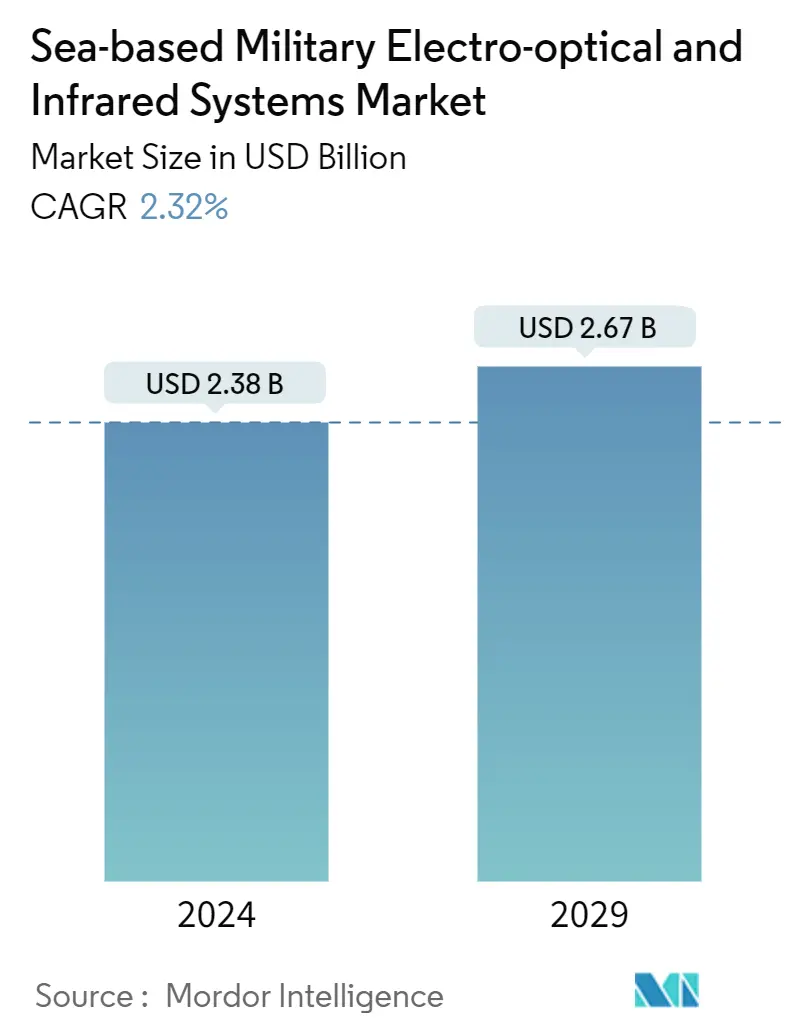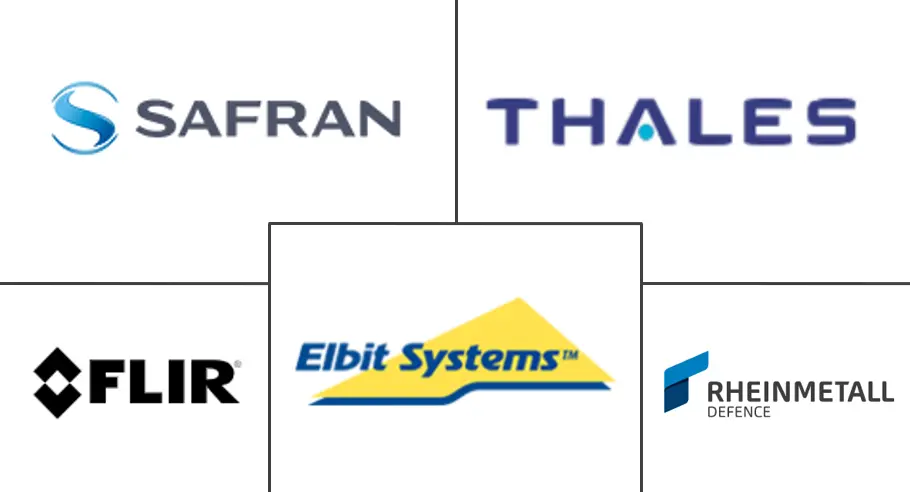Market Size of Sea-based Military Electro-optical And Infrared Systems Industry

| Study Period | 2019-2029 |
| Market Size (2024) | USD 2.38 Billion |
| Market Size (2029) | USD 2.67 Billion |
| CAGR (2024 - 2029) | 2.32 % |
| Fastest Growing Market | Asia Pacific |
| Largest Market | North America |
| Market Concentration | Medium |
Major Players
*Disclaimer: Major Players sorted in no particular order |
Sea-Based Military Electro-Optical & IR Systems Market Analysis
The Sea-based Military Electro-optical And Infrared Systems Market size is estimated at USD 2.38 billion in 2024, and is expected to reach USD 2.67 billion by 2029, growing at a CAGR of 2.32% during the forecast period (2024-2029).
Many countries are investing in sophisticated electro-optical and infrared (EO/IR) systems for maritime purposes, including threat detection, surveillance, and target identification, due to the rise in maritime conflicts and dangers to naval vessels around the world.
The increasing tensions among nations in the vicinity of the Northern Atlantic and Arctic waters and the South China Sea are fueling the expansion of naval vessel and boat production and acquisition. This aspect is driving the market growth of electro-optical and infrared systems for military use at sea. Technological innovations are also fueling the development of advanced EO/IR systems worldwide. The use of sensor-based imaging and tracking systems that rely on EO/IR technology gives navies an advantage in extreme weather and day/night situations, thus improving their situational awareness while at sea.
Sea-Based Military Electro-Optical & IR Systems Industry Segmentation
Electro-optical and infrared systems, also referred to as EO/IR systems, cover a wide range of distinct technologies based on targets and their missions. These sensors include both visible spectrum and infrared sensors, due to which EO/IR systems provide total situational awareness during both day and night, even in low light conditions. Their applications include, but are not limited to, security, combat, patrol, surveillance, reconnaissance, and search and rescue operations.
The sea-based military electro-optical & IR systems market is segmented by imaging technology and geography. By imaging technology, the market is segmented into multispectral and hyperspectral. The report also covers the market sizes and forecasts for the sea-based electro-optical & IR systems market in major countries across different regions. For each segment, the market size is provided in terms of value (USD).
| Imaging Technology | |
| Multispectral | |
| Hyperspectral |
| Geography | ||||||||
| ||||||||
| ||||||||
| ||||||||
| ||||||||
|
Sea-based Military Electro-optical And Infrared Systems Market Size Summary
The sea-based military electro-optical and infrared systems market is experiencing growth driven by increasing global maritime conflicts and the need for advanced surveillance and threat detection capabilities. Nations are investing heavily in sophisticated EO/IR systems to enhance their naval vessels' situational awareness and operational effectiveness. This demand is fueled by rising tensions in strategic regions such as the Northern Atlantic, Arctic waters, and the South China Sea, prompting countries to expand their naval fleets and upgrade their maritime defense technologies. Technological advancements in sensor-based imaging and tracking systems are providing navies with significant advantages in both day and night operations, further propelling market growth.
In the Asia-Pacific region, the demand for these systems is particularly strong due to escalating tensions and territorial disputes. Countries like China and Japan are actively modernizing their naval capabilities, integrating advanced EO/IR technologies into their vessels. This includes the development of sophisticated radar and sensor systems to enhance maritime domain awareness and targeting accuracy. The market is semi-consolidated, with key players such as Elbit Systems Ltd, Rheinmetall AG, and Teledyne FLIR LLC leading the charge in innovation and technology development. These companies are capitalizing on the growing naval market by securing contracts for new installations and system upgrades, thereby driving the market's expansion during the forecast period.
Sea-based Military Electro-optical And Infrared Systems Market Size - Table of Contents
-
1. MARKET DYNAMICS
-
1.1 Market Overview
-
1.2 Market Drivers
-
1.3 Market Restraints
-
1.4 Porter's Five Force Analysis
-
1.4.1 Threat of New Entrants
-
1.4.2 Bargaining Power of Buyers/Consumers
-
1.4.3 Bargaining Power of Suppliers
-
1.4.4 Threat of Substitute Products
-
1.4.5 Intensity of Competitive Rivalry
-
-
-
2. MARKET SEGMENTATION
-
2.1 Imaging Technology
-
2.1.1 Multispectral
-
2.1.2 Hyperspectral
-
-
2.2 Geography
-
2.2.1 North America
-
2.2.1.1 United States
-
2.2.1.2 Canada
-
-
2.2.2 Europe
-
2.2.2.1 Germany
-
2.2.2.2 United Kingdom
-
2.2.2.3 France
-
2.2.2.4 Russia
-
2.2.2.5 Rest of Europe
-
-
2.2.3 Asia-Pacific
-
2.2.3.1 India
-
2.2.3.2 China
-
2.2.3.3 Japan
-
2.2.3.4 South Korea
-
2.2.3.5 Australia
-
2.2.3.6 Rest of Asia-Pacific
-
-
2.2.4 Latin America
-
2.2.4.1 Brazil
-
2.2.4.2 Rest of Latin America
-
-
2.2.5 Middle East and Africa
-
2.2.5.1 Saudi Arabia
-
2.2.5.2 Egypt
-
2.2.5.3 Israel
-
2.2.5.4 Rest of Middle East and Africa
-
-
-
Sea-based Military Electro-optical And Infrared Systems Market Size FAQs
How big is the Sea-based Military Electro-optical And Infrared Systems Market?
The Sea-based Military Electro-optical And Infrared Systems Market size is expected to reach USD 2.38 billion in 2024 and grow at a CAGR of 2.32% to reach USD 2.67 billion by 2029.
What is the current Sea-based Military Electro-optical And Infrared Systems Market size?
In 2024, the Sea-based Military Electro-optical And Infrared Systems Market size is expected to reach USD 2.38 billion.

